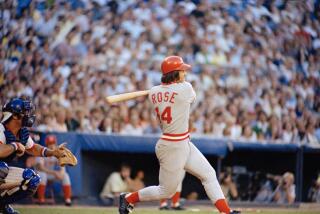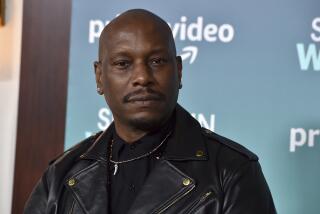WHEN BASEBALL WAS DOMINATED AND DOMINEERING : Black Cardinals Dealt Away Prejudice, Fear
There was this time during the indignity years, when Bob Gibson was told where he could live in spring training because he couldn’t live with the white Cardinals. And he laughed at the memory, 33 or 34 years later. Nobody cared to check whether they were breaking curfews or eating well or getting rest or anything like that.
“We had complete freedom,” Gibson recalled with that hot-eyed look he used to flash on the mound. “The club rented this old taxi for us to get back and forth to the field. Nobody messed with us.”
One day he said to George Crowe, the sage of the black players then, “Do you think they’re having as much fun as we are?”
And Crowe said, in Gibson’s memory, “No way.”
And, of course, it was the absolute lie. Perhaps it was intended to deceive themselves.
The monumental baseball series on public television had taken us who weren’t there into the time of the Negro leagues and the indignity of being excluded. Gibson and Crowe, Curt Flood, Bill White endured the transition, when they could play big league baseball if they were good enough, but weren’t permitted to live as big leaguers no matter how good they were. Still Gibson recalls the Cardinals of his time the way combat veterans recall the devotion--even love--of the men whose lives they shared.
In his just-published book, “Stranger to the Game,” Gibson takes a line from “The Way It Is,” by Flood: “The men of that team were as close to being free of racist poison as a diverse group of 20th-century Americans could possibly be.” Gibson is making the rounds promoting the book. He said the evaluation still holds. Gibson loved being on that team with Stan Musial; Ken Boyer, the “blue-eyed devil;” Tim McCarver, the wide-eyed kid from Memphis outgrowing his racism; Joe Torre, Lou Brock, White, Flood and Manager Johnny Keane.
Gibson’s innings were the 1960s, when he was as fearsome a pitcher as ever glared down a hitter. He was so good in 1968--at one stretch he permitted two earned runs over eight weeks--that he was at the center of a rule that lowered the mound to give the hitters a chance. His time came out of the 1950s, when he was told there would be no basketball scholarship for this kid from Omaha to Indiana University.
That was my school. The letter came back to Gibson’s high school coach that the “quota of Negroes” had been filled. IU had selected Hallie Bryant from Oscar Robertson’s high school in Indianapolis. Bryant started as a senior; Gibson went on to star at Creighton. He writes about watching Bryant on TV and thinking, “They got the wrong Negro.” Indeed.
He spent a winter playing with the Globetrotters and left. “It wasn’t demeaning,” Gibson recalled Tuesday. “It was entertainment; I understood that. I wanted to kill.”
That’s a pretty good self-description of a pitcher who could move a hitter away from the plate and then drop a slider on the outside corner. He’d put on this fearsome mien, never speaking to an opponent, challenging a newspaper man, hiding real insight by bristling. He wasn’t mean, and there was insight. “I test everybody--always,” he said. “Still do. If they handle it, fine. If they don’t, they never go through it again.”
In the spring of 1958 he went to St. Petersburg to be a Cardinal, went on a train, somehow eluding three guys who threatened to rough him up for being black. He walked across the street from the station to the Bainbridge Hotel, team headquarters. He was directed to a side door where a taxi awaited to take him to a boarding house in the black part of town.
Elston Howard was staying there, and Crowe, Marshall Bridges, Ellis Burton, and more, in this lady’s house. “Edith,” Gibson said. “Man, she was the meanest woman. We got $54 a week for living expenses and she took $49. She gave us two meals a day; we ate what she had. Talk about a strong person.”
This was 1958 through 1961. “We knew it wasn’t right, but what were we going to do?” Gibson said. In 1960, when he was a Cardinal, he drove from Nebraska to Florida, stopping only at cities that might have a black section with a motel, stopping only at major gas stations to avoid confrontations. “My daughters had to go to the bathroom,” Gibson said. “And I asked the guy if he had one. He said, ‘We have one for you around back.’ I looked into this hole, dirtier than anything I’d seen until I saw the bathroom at City Hall here yesterday. (Book tours will open a man’s eyes.)
“I told the kids to go in the bushes. I told the guy to cut off the gas.” The indignity suffered by the man and his wife--the mother and the father--is not explained easily 30 years later.
“You deal with it,” he reflected. “You don’t forget it. Patience never was one of my virtues. George Crowe taught me patience. I’m better now.”
In 1962 some St. Louis people bought a comfortable motel in St. Petersburg with arrangements to rent to the Cardinals--all of them. And the likes of Musial and Boyer, the giants, passed up their individual comforts to stay with the team. “There had been no intermingling away from the field,” Gibson said. “Friendship is what you do after the ballgame. You get over fears and prejudice when you get to know people.”
Gibson and McCarver grew close when they could stay together. “I didn’t test Boyer; we respected each other an awful lot,” Gibson said. “McCarver was an 18-year-old who didn’t have much use for blacks. He went 180 degrees, evolving into a wonderful person from a snot-nosed kid. He’d say the same.”
Gibson would say much the same of his own evolution. I remember how he couldn’t straighten his arm. I remember Dal Maxvill, the shortstop, telling how he’d gone to the mound in the seventh game of the 1967 World Series--the day the Boston newspaper headlined “Lonborg and Champagne”--and knowing by Gibson’s eyes that he wouldn’t lose. “Those babies,” Maxvill said, “were burning.”
Legend says Gibson deliberately hit Tommie Agee with the first pitch he saw as a National Leaguer. Gibson insists that wasn’t so. It was his reputation and it served him well. He was such a competitor Joe Torre brought him to the Mets as “attitude coach.” Years later Gibson and Maxvill had a falling out. When Torre wanted Gibson to coach for the Cardinals, Maxvill, then the general manager, blocked it. Gibson says he thinks the issue is “deeper than that,” but can’t or won’t elaborate. He still has something to give young players, but it’s not likely to happen now.
He has his own status and valued relationships. Unlike army buddies, a number of those Cardinals have maintained their links. Gibson often stays at Torre’s home. Gibson and McCarver keep in touch, see each other, hunt together. And Gibson can recall the times when the black Cardinals weren’t allowed to stay with the red Cardinals, and wasn’t that fun.
More to Read
Go beyond the scoreboard
Get the latest on L.A.'s teams in the daily Sports Report newsletter.
You may occasionally receive promotional content from the Los Angeles Times.










